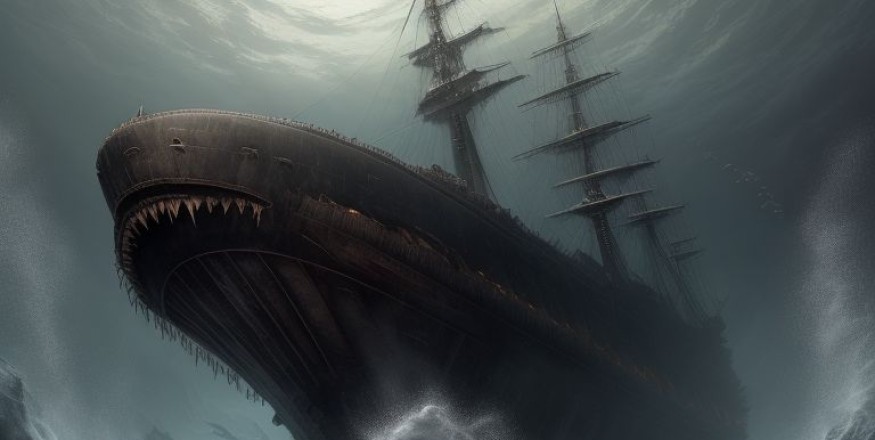 x
x
Dr. Sebastian Stormrider, director of the Abyssal Discovery Institute, had a personality that meshed with both his august title and his reputation as a scientist---dispassionate and unflappable.
Except that on this cold, blustery morning in March 1995, the mood of Dr. Sebastain Whitestone Stormrider (B.S., M.A., Ph.D.) didn't fit that description. He was more than visibly upset, he was shaken, to the point where his hands trembled as he read, for the third time, the letter he had plucked from the mail his secretary had deposited on his desk less than one hour ago.
Stormrider had been sifting through the pile, trying to decide what looked vital or interesting enough to open first, when he spotted "Office of Naval Research," in the upper-left corner of one envelope. This he'd torn open with the enthusiasm of a four-year-old attacking Christmas wrapping, but his initial reaction was dismay at the unwanted contents. A second reading had given Stormrider the urge to throw the lengthy letter against the wall.
The letter itself was not a surprise---he'd been waiting for it for a long time---but what it disclosed was not what he had hoped. No, Stormrider thought glumly. Rear Admiral Kirk McAllister, known throughout the United States Navy as "Old Leadbottom," wasn't the type to sugar-coat bad news. McAllister said what he meant and meant what he said, a trait the scientist had always admired for the more than twenty years of their friendship. Stormrider suddenly wished he hadn't started the whole mess.
Should I tell Paul Castro about this? was the next thing that popped into his head. No, he decided quickly. The last sentence in McAllister's letter----"I urge you to see me in Washington at your earliest convenience to discuss this matter"----dictated caution, not to mention discretion. Dr. Paul Castro, the discoverer and first explorer of the wreck of an impossibly huge sailing ship at the bottom of the Atlantic, believed to be the legendary USS Leviathan, didn't have to know until Stormrider himself was ready to tell him.
"Yes, Dr. Stormrider?"
"Sarah, call United and get me on the first available plane to Washington tomorrow morning. And then call Admiral McAllister."
Having crossed this red line, he felt a little better. That is, until he made the mistake of rereading the letter:453Please respect copyright.PENANAAdQQS3I7Fp
453Please respect copyright.PENANAn4dqcXkUhM
Dear Sebastian,
I hope this letter finds you well. I have some news—both good and bad—that I believe will pique your interest. The good news is that there's enough compelling evidence to support your theory regarding the impossibly huge wreck I discovered at the bottom of the Atlantic. After thorough analysis and consultation with experts, it seems increasingly likely that we have indeed stumbled upon the legendary USS Leviathan. However, before we celebrate this remarkable discovery, I must also share the bad news: it appears that we are not the first to have found it.
The plot thickens with each revelation. Allow me to recount the curious tale of the enigmatic film discovered in the archives of a defunct Dallas, Texas TV station back in 1986. The film, shot sometime in the mid-'60s, depicted scenes of underwater exploration—scenes strikingly similar to what I encountered during my expedition. Initially dismissed as a hoax due to its unconventional origin, the film has resurfaced as a key piece of evidence in our investigation.
Upon closer examination, I was astonished to find that stills from the film perfectly matched the images I captured during our exploration of the wreck. It was as though someone had captured the Leviathan on film decades before our discovery. However, the most perplexing aspect of the footage was a mysterious blip towards the end—a fleeting glimpse of a scuba diver frantically swimming away from... what, exactly, remains a mystery. The terror etched on the diver's face was palpable, and just as abruptly as it began, the film ended.
In my relentless quest for the truth, I have uncovered a shocking revelation about the true discoverer of the Leviathan—none other than Billy Riker. Riker's name might sound familiar; he has long been an enigmatic figure, known for his unorthodox methods and insatiable curiosity about maritime mysteries.
Riker's journey began with visits to maritime museums across the country. He meticulously gathered information about the Leviathan's supposed missions, including the destruction of Al-Malikya. His interest was piqued by rumors of the ship's unprecedented firepower and its enigmatic captain, Commodore Phineas E. Cartwright. Driven by a conviction that the Leviathan did indeed exist, Riker delved into its history with the zeal of a man possessed.
Riker's background in physics and espionage added a layer of complexity to his pursuits. He was a former operative for an obscure branch of the Defense Intelligence Agency, specializing in advanced naval technologies and underwater reconnaissance. His skills and resources were unparalleled, allowing him to piece together the fragmented clues that others had overlooked.
It was Riker who first set this bizarre tale in motion. Using his extensive network of contacts and his expertise in deep-sea exploration, he mounted a covert expedition in the mid-'60s. The mysterious film found in the Dallas TV station archives was shot by his team, believe it or not. The film's authenticity, now confirmed by our matching photographs, is a testament to Riker's extraordinary discovery.
Riker's belief in the Leviathan's existence was unwavering, driven by a sense of destiny and a need to uncover the truth at any cost. His findings, though initially dismissed, laid the groundwork for our current understanding of this legendary ship. As we continue to unravel the mysteries of the Leviathan, we must acknowledge the profound impact of Riker's conviction and perseverance.
Sincerely,453Please respect copyright.PENANAlFRUAJlMrh
Paul





















